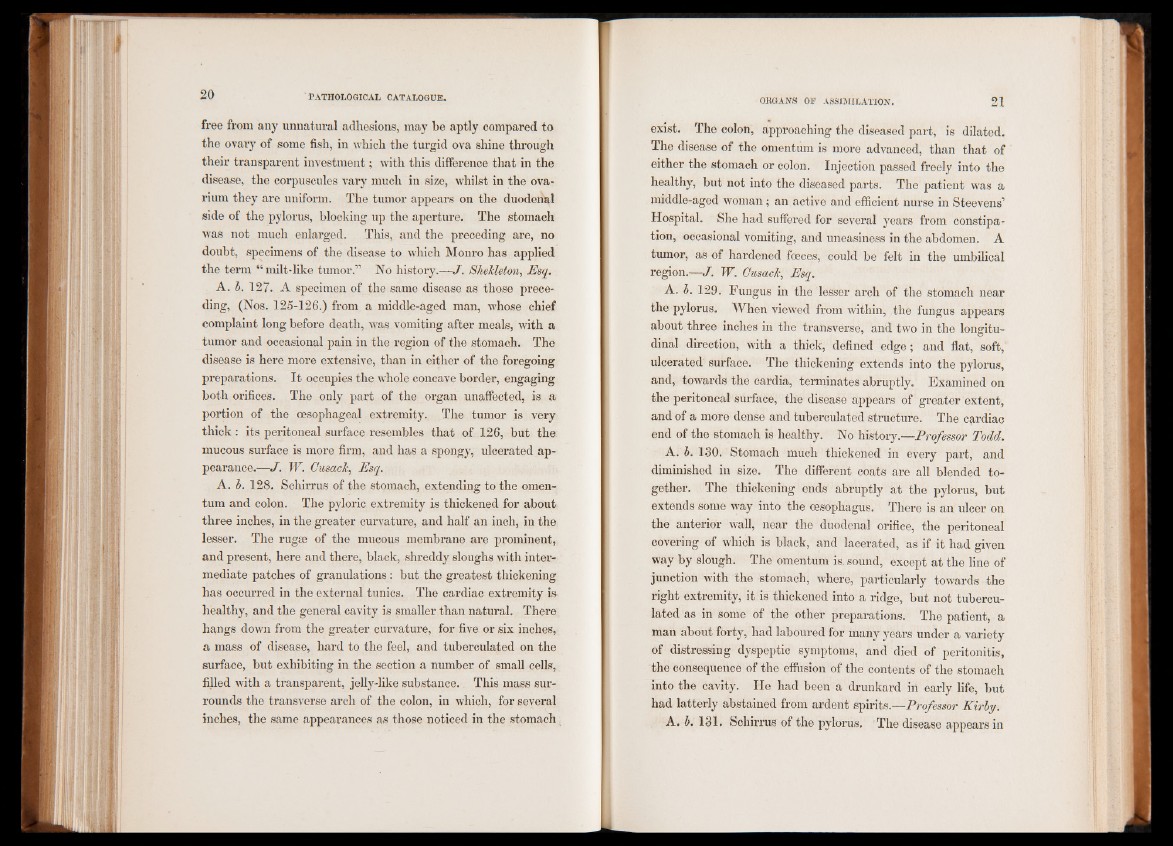
free from any unnatural adhesions, may be aptly compared to
the ovary of some fish, in which the turgid ova shine through
their transparent investment; with this difference that in the
disease, the corpuscules vai’y much in size, whilst in the ovarium
they are uniform. The tumor appears on the duodenal
side of the pylorus, blocking up the aperture. The stomach
was not much enlarged. This, and the preceding are, no
doubt, specimens of the disease to which Monro has applied
the term “ milt-like tumor.” No history.—J. Shekleton, Esq.
A. b. 127. A specimen of the same disease as those preceding,
(Nos. 125-126.) from a middle-aged man, whose chief
complaint long before death, was vomiting after meals, with a
tumor and occasional pain in the region of the stomach. The
disease is here more extensive, than in either of the foregoing
preparations. It occupies the whole concave border, engaging
both orifices. The only part of the organ unaffected, is a
portion of the oesophageal extremity. The tumor is very
thick : its peritoneal surface resembles that of 126, but the
mucous surface is more firm, and has a spongy, ulcerated appearance.—
J. W. Cusack, Esq.
A. b. 128. Schirrus of the stomach, extending to the omentum
and colon. The pyloric extremity is thickened for about
three inches, in the greater curvature, and half an inch, in the
lesser. The rugse of the mucous membrane are prominent,
and present, here and there, black, shreddy sloughs with intermediate
patches of granulations: but the greatest thickening
has occurred in the external tunics. The cardiac extremity is-
healthy, and the general cavity is smaller than natural. There
hangs down from the greater curvature, for five or six inches,
a mass of disease, hard to the feel, and tuberculated on the
surface, but exhibiting in the section a number of small cells,
filled with a transparent, jelly-like substance. This mass surrounds
the transverse arch of the colon, in which, for several
inches, the same appearances as those noticed in the stomach
exist. The colon, approaching the diseased part, is dilated.
The disease of the omentum is more advanced, than that of
either the stomach or colon. Injection passed freely into the
healthy, but not into the diseased parts. The patient was a
middle-aged woman; an active and efficient nurse in Steevens’
Hospital. She had suffered for several years from constipation,
occasional vomiting, and uneasiness in the abdomen. A
tumor, as of hardened foeces, could be felt in the umbilical
region.—J. W. Cusack, Esq.
A. b. 129. Fungus in the lesser arch of the stomach near
the pylorus. When viewed from within, the fungus appears
about three inches in the transverse, and two in the longitudinal
direction, with a thick, defined edge; and flat, soft,
ulcerated surface. The thickening extends into the pylorus,
and, towards the cardia, terminates abruptly. Examined on
the peritoneal surface, the disease appears of greater extent,
and of a more dense and tuberculated structure. The cardiac
end of the stomach is healthy. No history.—Professor Todd.
A. b. 130. Stomach much thickened in every part, and
diminished in size. The different coats are all blended together.
The thickening ends abruptly at the pylorus, but
extends some way into the oesophagus. There is an ulcer on
the anterior wall, near the duodenal orifice, the peritoneal
covering of which is black, and lacerated, as if it had given
way by slough. The omentum is. sound, except at the line of
junction with the stomach, where, particularly towards the
right extremity, it is thickened into a ridge, but not tuberculated
as in some of the other preparations. The patient, a
man about forty, had laboured for many years under a variety
of distressing dyspeptic symptoms, and died of peritonitis,
the consequence of the effusion of the contents of the stomach
into the cavity. He had been a drunkard in early life, but
had latterly abstained from ardent spirits.—Professor Kirby.
A. b. 131. Schirrus of the pylorus. The disease appears in